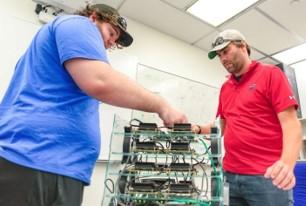Recipe for a baby supercomputer: 16 Nvidia Jetson Nano modules, four power supplies, 60 handmade wires, a network switch and cooling fans.
Yield: a supercomputer small enough to sit on a desktop. Students at Southern Methodist University in Dallas can check the status of the nodes on a touchscreen display.
Why: to demonstrate what goes inside a computer cluster, according to Eric Godat, team lead for research and data science in internal IT at SMU. (Godat holds a Ph.D. in theoretical particle physics from SMU, comparable, perhaps, to graduating from Le Cordon Bleu in Paris to become a master chef and not a bad preparation for work in artificial intelligence and related fields .)
SMU’s baby supercomputer will be put on display at SC22, a supercomputing conference being held on the grounds of SMU next week. Students will work a booth at the event to meet with researchers. Tours of the SMU data center will showcase a DGX SuperPOD from Nvidia.
Godat mentored Conner Ozenne, a senior computer science major at SMU who helped conceive the idea for the cluster. The group won a grant of $2,000 to kick off the project.

Ozenne told Nvidia he first studied computer science in high school because programming fulfilled the foreign language requirement. (So French lessons were out? Doesn’t fit the theme here.) He hopes to integrate AI with web design for his career.
The baby supercomputer was built from scratch. Ozenne chose Nvidia Jetson modules because they are small and had onboard GPUs to help tackle more AI and machine learning problems. He started with cardboard, then foam and finally acrylic plates that were laser cut from 3D vector files.
Of course, hardware is one thing. Now the team is developing software, using an Nvidia JetPack dev kit. However, the mini cluster will act as a teaching tool with the actual heavy lifting compute handled by the DGX SuperPOD nearby.